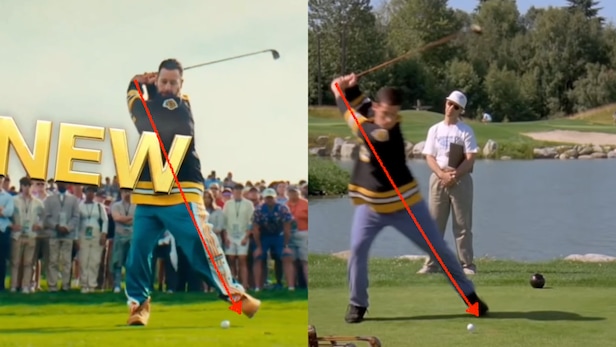‘I hate this golf course’: The modern terms of endearment for architectural frustration – Australian Golf Digest

- by Admin
- June 14, 2024

The first time the term might have been used was at Royal St. George’s in 1999 when golf’s boulevardier Jimmy Dunne was playing a casual match with his friend Frank Brennan while attending Wimbledon. On the long par-3 11th hole, Brennan hit a slight hook into the right side of the green and appeared satisfied with the result as he turned to put away his club.
“Hey, Frankie, take a look at this,” chirped Jimmy, as the ball slowly slid off the left edge of the green into a sod-faced bunker that Dunne described to me recently as resembling a World War I foxhole.
“I hate this golf course,” Brennan said.
“You didn’t hit the green in regulation,” exulted Dunne. “You visited the green in regulation.”
Pete Sampras won Wimbledon that year, but it was David Duval who led the PGA Tour in hitting Greens in Regulation (GIR) with a 73.57 average. GIR may have been invented by Ben Hogan or Moe Norman or Calvin Peete, but it was first calculated officially in 1980 when Jack Nicklaus led the statistical category (72.11) with the highest percentage for having a ball finish on the putting surface in the number of strokes equal to par minus two.
The consequence—not the tongue-in-cheek term Greens Visited in Regulation (GVIR)—has been around as long as golf has been played on the hardscrabble links of Great Britain and Ireland, where you’ve always had to watch till your ball stopped rolling.
“I fell in love with that idea,” Dunne was saying now. “Brown is beautiful—the links courses always knew that. Firm, brown and fast is the ideal surface for golf. I remember an old pro telling me, ‘You don’t want to be hitting into a bowl of pudding.’ ”
Jimmy Dunne during the first day of the Alfred Dunhill Links Championship at Carnoustie Golf Links in October 2023
Ross Parker – SNS Group
MORE: Does the USGA have an obligation to make America’s golf meccas more accessible?
Jimmy Dunne is recognized at all the great golf clubs of the world—and not just for negotiating a framework agreement that his minions can’t finish off—but he is especially known at Seminole Golf Club in Florida where being “de-greened” is held to an architectural art form. Dunne is the longtime president of Seminole, its capo dei capi. He credits his predecessors and membership for having a “high golf aptitude.” They want the course to play “harder the closer you get to the hole,” which is a novel concept for most American golfers. Seminole is not for tourists, he says. It’s where people come to play serious golf.
“They drive right down Donald Ross Boulevard past all these fun courses in Palm Beach to beat their head against the wall at Seminole,” Pete Dye, a member, once told me.
The course is known for what may or may not have been Donald Ross-designed turtleback greens. We don’t really know how much they resemble what Ross built originally in 1929 because they’ve been punched and top-dressed and blasted with sand, even scraped and reconstructed, a million times since, but today in all their convex beauty, Seminole greens reject anything but the perfectly conceived and executed approach shot. Sometimes even perfection—with bad luck and the vagaries of wind gusting off the Atlantic Ocean—only visits the putting surfaces. (“I was gusted,” Gil Hanse says is another 21st Century golf term.)

A ground crew member waters the 13th green during the second round of the 124th U.S. Open at Pinehurst Resort.
Jared C. Tilton
You hear GVIR used frequently at another Donald Ross masterpiece, Pinehurst No. 2, site of this year’s U.S. Open. Bill Coore, who did the renovation with Ben Crenshaw, says No. 2 has the biggest differential between GIR and GVIR of any course in the United States. “Those crowned greens shed balls rather than collect them,” Coore says.
“False fronts” is another architectural feature that has been around since Alister MacKenzie but popularized in the past 20 years with the addition of “false sides” and “false backs.”
“Those are actually misnomers,” says Ron Whitten, Golf Digest’s architecture editor emeritus. “There’s nothing false about them. They’re un-pinnable and un-puttable and classic elements of visual design like the ninth at Augusta National or the 15th at Pine Valley.” There’s little more frustrating in life than having your ball stop short on an upslope and then seeing it roll back glacially, inch by inch at first, then by the foot, then many yards as it gathers speed downhill rushing to a full wedge return—only to do it again.
Another modern expression is leaving yourself “short-sided.” It was probably invented by a TV analyst to describe a short pitch over a bunker or false front to a hole location precipitously close to the brink. The PGA Tour used to mandate that holes be cut no nearer than five paces from the edge of a putting surface, says longtime rules expert Joe Black. The guideline on tour now is a minimum of three paces, which puts an even greater premium on accuracy.
“We will usually use these types of locations on smaller greens where they fit visually to the player,” says tour official Gary Young. Exacerbating this challenge is increased green speed, now commonly 12 or 13 on the Stimpmeter in tournament play (9 or 10 in regular play) and significantly firmer subsurfaces. At the Masters this year, balls seemed to be bounding off greens with almost a concrete thud.
Agronomic technology and maintenance equipment have contributed to changing the way we play much more so than the club and ball innovations that our governing bodies are trying to arrest. “We have more tools under the ground,” Hanse says. One example is the SubAir Systems being installed at many high-end courses, pumping air in or sucking water out so that greens play firmer and faster.
“We may not be able to guarantee you blue skies,” says SubAir’s website, “but we can ensure impeccable greens and superior field conditions. Why? Because it all starts from the roots up. That explains our company’s name and its focus. Superior surface and subsurface aeration. Optimal moisture removal. Incredible results.”
We’ll be the judge of that.
Frankie Brennan is no longer with us. He was a victim of September 11, but we still know the feeling he had when visiting a green in regulation or failing to clear a false front or getting gusted or short-sided in modern terms.
“I hate this golf course” is what golfers forever have been saying when what they mean is, “I love this game.”
MORE GOLF DIGEST U.S. OPEN COVERAGEU.S. Open 101: Answering all your frequently asked questionsHow to watch the 2024 U.S. OpenPower Rankings: Every player in the U.S. Open field, rankedThe 13 best bets to win at Pinehurst‘A New Day’: USGA president Fred Perpall brings dynamic personality and drive to golfVideo: Every hole at Pinehurst No. 2Is the USGA going to set up Pinehurst extra hard because of recent low scores in majors?Tiger is playing Pinehurst on a special exemption. Here’s what it is and why he got itWhat would you shoot at the U.S. Open? Our new tool will tell youU.S. Open anchor sites are about far more than golfThe U.S. Open champion who died in a jail cellThe USGA is about to play its 1,000th championship. The best 9 stats from the first 999
This article was originally published on golfdigest.com
The Latest News
-
December 27, 2024Australian media is calling for Virat Kohli to be ‘hanged’ amid Sam Konstas controversy, says Sunil Gavaskar | Sporting News India
-
December 27, 2024The year in big business news, according to Taylor Swift
-
December 27, 2024Foxtel’s sale could change the game for two sports in Australia
-
December 27, 2024Tennis: Injury forces Simona Halep to withdraw from Australian Open 2025
-
December 27, 2024The secret post-sandpaper-gate change that saved Virat Kohli from suspension





